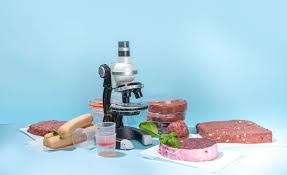
Lab-Grown Meat: The Future of Food or Frankenstein Feast?
Imagine biting into a juicy burger that was never part of a cow but grown entirely in a lab. Sounds like science fiction? Not anymore.
Lab-grown meat, also called cultured or cell-based meat, is emerging as a revolutionary way to produce animal protein without slaughtering animals or harming the environment. But is this innovation the future of food—or a “Frankenstein feast” we should be wary of?
Also check for : space-junk-crisis-is-earths-orbit-getting-too-crowded
🍔 What Is Lab-Grown Meat?
Lab-grown meat is real animal meat produced by culturing animal cells directly in a controlled environment. Scientists take a small sample of animal muscle cells and feed them nutrients to grow into tissue—no antibiotics, no hormones, and no animal slaughter involved.
The result? Actual meat that looks, cooks, and tastes like traditional meat but is made in bioreactors.
🌱 Why the Buzz Around Lab Meat?
Traditional meat production faces huge challenges:
-
Environmental Impact: Livestock farming generates nearly 15% of global greenhouse gases and uses vast land and water.
-
Animal Welfare: Ethical concerns over factory farming conditions.
-
Health Risks: Antibiotic use and zoonotic diseases pose ongoing risks.
Lab-grown meat offers potential solutions:
-
Reduced carbon footprint.
-
Animal-friendly production.
-
Less risk of foodborne illnesses.
🔬 The Science Behind It
Creating cultured meat involves:
-
Cell Harvesting: Collecting muscle stem cells from a living animal.
-
Cell Culturing: Feeding the cells with a nutrient-rich broth to multiply.
-
Tissue Engineering: Encouraging cells to form muscle fibers and fat, creating real meat textures.
-
Scaling Up: Developing large bioreactors to produce commercial quantities.
Recent breakthroughs have improved texture, taste, and cost, bringing products closer to your plate.
🍽️ Is It Safe and Healthy?
Lab-grown meat must pass rigorous safety and regulatory tests before hitting markets. So far, early products have shown promising nutritional profiles—high in protein, low in contaminants.
However, long-term health impacts are still under study, and consumer acceptance remains a hurdle.
🐄 The Ethical and Economic Debate
-
Supporters say lab meat could end factory farming, reduce animal suffering, and combat climate change.
-
Critics argue it’s unnatural, heavily processed, and may threaten traditional farming jobs.
-
Price is also an issue—currently, lab meat is expensive, but costs are expected to drop with technological advances.
🚀 When Will Lab Meat Be on Your Menu?
The first lab-grown meat was served in 2013 at a high price. Today, some companies have launched products in limited markets, mostly in Asia and Europe.
Experts predict wider availability within the next 5 to 10 years as production scales and prices drop.
🧠 Final Thought
Lab-grown meat could redefine how we feed the world sustainably and ethically. But it’s not without controversy and challenges—from consumer trust to economics.
Whether it becomes the future staple or remains a niche “Frankenstein feast” depends on science, policy, and society’s open-mindedness.